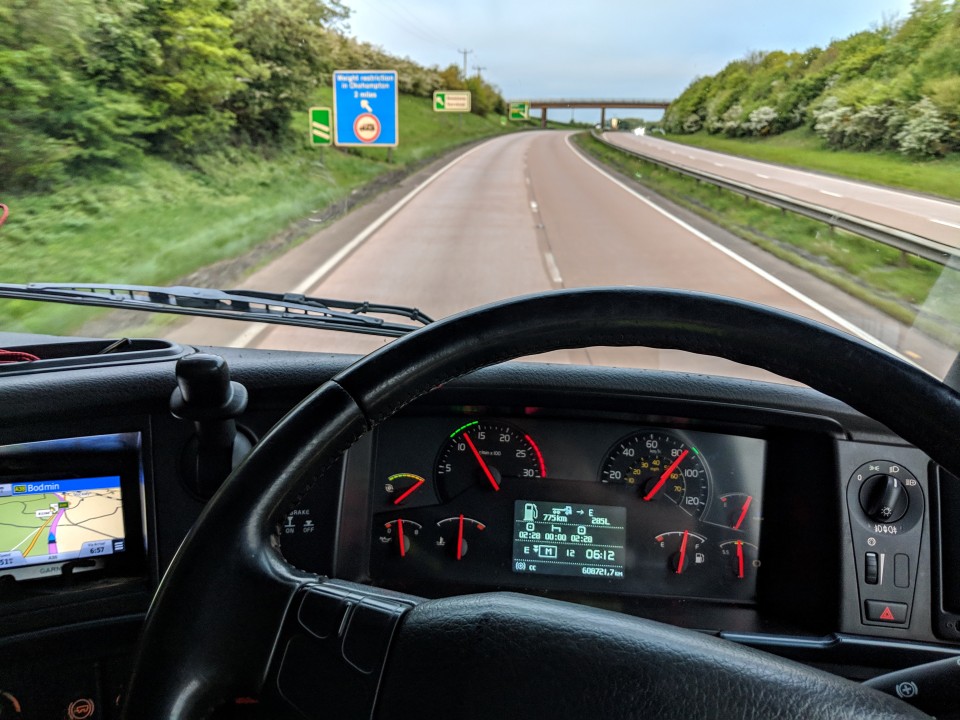
Susie Jones
Les règles du tachygraphe simplifiées
Créée: 01/08/2024
•
Mise à jour : 08/08/2024
Le monde des règles relatives aux tachygraphes peut être déroutant pour le conducteur de camion le plus expérimenté. Sans parler des nouveaux venus dans le secteur. Notre objectif est de dissiper cette confusion.
Qu'est-ce qu'un tachygraphe et pourquoi en avons-nous ?
Selon le dictionnaire, un tachygraphe est "un appareil installé dans des véhicules tels que les camions et les autocars afin d'enregistrer des informations telles que la vitesse du véhicule, la distance parcourue et le nombre de pauses prises par le conducteur".
L'objectif d'un tachygraphe est de prévenir la fatigue des conducteurs et de s'assurer que les conducteurs et les employeurs respectent les règles. [L'association de sécurité routière Brake] (https://www.brake.org.uk/get-involved/take-action/mybrake/knowledge-centre/driver-fatigue) a indiqué que "quatre accidents sur dix liés à la fatigue impliquent un conducteur de véhicule utilitaire". Les règles du tachygraphe jouent donc un rôle essentiel dans la réduction de ce nombre.
Quand avez-vous besoin d'un tachygraphe ?
Vous devez installer un tachygraphe si le poids total en charge de votre véhicule dépasse trois tonnes et demie. Il est important de se rappeler que cela inclut la traction d'une remorque. Il existe quelques exceptions à cette règle :
Si vous ne conduisez que sur des voies publiques
Si le véhicule est conduit par les forces armées, la police ou les pompiers
Si vous êtes une flotte commerciale et que vous utilisez des véhicules d'un poids maximal de sept tonnes et demie, et que votre trajet est inférieur à 100 km de votre base d'exploitation.
Si vous transportez des marchandises et que votre véhicule est électrique
Si vous transportez du matériel ou des machines à l'usage du conducteur et que la conduite de ce véhicule n'est pas votre activité principale.
Quels sont les différents types de tachygraphes ?
Il existe trois types de tachygraphes :
Analogiques : Ils ont été rendus obligatoires en Europe en 1986. Les tachygraphes analogiques utilisent des feuilles de papier ciré pour enregistrer les données du conducteur. Les conducteurs saisissent manuellement les données et les insèrent dans un tachygraphe.
Numérique : Ils ont été introduits en 2006. Ils sont utilisés par plus d'un million d'entreprises de transport et plus de six millions de conducteurs professionnels. Les tachygraphes numériques enregistrent les données du conducteur sur un dispositif de stockage interne et sur la carte du conducteur.
Intelligent : À partir de juin 2019, l'Union européenne exige que les entreprises utilisent des tachygraphes intelligents. Ceux-ci enregistrent automatiquement la position du véhicule au début et à la fin de chaque trajet. Ils fournissent également des mises à jour toutes les trois heures
Que signifie chaque symbole du tachygraphe ?
Consultez notre [vidéo] (https://www.youtube.com/watch?v=dgqGmlu9LfM&t=3s) expliquant chaque symbole du tachygraphe.
Règles de conduite
Pour la sécurité du conducteur de camion et de tous les autres usagers de la route, les règles de rupture doivent être respectées. Nous vous en présentons les points essentiels.
Temps de conduite :
- Ne peut excéder quatre heures et demie avant une pause.
Pauses :
- Elles doivent être d'au moins 45 minutes, sauf si le conducteur prend une période de repos.
Période de repos :
- Pendant une période de repos, il n'est pas possible de conduire ou d'effectuer d'autres travaux.
Fractionnement des pauses :
Une pause complète de 45 minutes peut être fractionnée en une pause de 15 minutes suivie d'une pause de 30 minutes.
Les pauses de fractionnement doivent être réparties sur les quatre heures et demie de temps de conduite
Selon les règles de l'UE, si les pauses sont fractionnées, la deuxième pause doit durer au moins 30 minutes.

Limite journalière de conduite
La limite journalière de conduite fait référence à la durée maximale de conduite dans une journée. Le maximum est de neuf heures, mais il peut être porté à dix heures. Toutefois, cela ne peut se faire plus de deux fois par semaine. La durée de conduite journalière peut être définie comme suit :
Le temps de conduite total accumulé entre la fin d'un temps de repos journalier et le début du temps de repos journalier suivant.
Le temps de conduite total accumulé entre un temps de repos journalier et un temps de repos hebdomadaire. .
Limite de conduite hebdomadaire et bihebdomadaire
Les conducteurs doivent s'assurer qu'ils ne dépassent pas les limites de conduite hebdomadaires et bihebdomadaires.
La durée maximale de conduite hebdomadaire est de 56 heures (pour une semaine fixe).
Une semaine fixe commence à 00h00 et se termine à 24h00 le dimanche suivant.
La limite de conduite par quinzaine est de 90 heures.
Repos quotidien
En outre, un repos quotidien doit être pris.
Le conducteur doit prendre 11 heures de repos continues. Cette durée peut être réduite à neuf heures
Cette réduction ne peut se produire que jusqu'à trois fois entre les périodes de repos hebdomadaires.
La période de repos doit être achevée dans les 24 heures suivant la fin de la dernière période de repos journalier ou hebdomadaire.
Le repos quotidien peut être pris dans le véhicule ; toutefois, des installations de couchage appropriées sont nécessaires. En l'absence de telles installations, le conducteur doit trouver un hébergement. Consultez notre page locations pour connaître les relais routiers qui proposent ce service.
Repos hebdomadaire
Les repos hebdomadaires doivent être pris au plus tard à la fin de six périodes consécutives de 24 heures à compter de la fin du dernier repos hebdomadaire.
Les conducteurs sont tenus de prendre au moins 45 heures de repos.
Ils peuvent prendre un repos hebdomadaire réduit d'au moins 24 heures.
Le repos hebdomadaire réduit doit être compensé en un bloc, et au moins neuf heures avant la fin de la troisième semaine.
Bien qu'il soit possible de prendre un repos réduit, il convient de noter que, au cours de deux semaines consécutives où un repos réduit a été pris, l'une d'entre elles doit être de 45 heures.

Multi manning
Certains conducteurs peuvent prendre un autre conducteur à bord. Les avantages sont une productivité accrue, un kilométrage plus élevé et une durée de conduite plus longue.
Les deux conducteurs doivent prendre neuf heures de repos quotidien
Ce repos quotidien doit être pris dans un délai de 30 heures au lieu de 24.
La première heure de multi-manning ne nécessite pas de conducteur supplémentaire. Après une heure, il devient obligatoire.
Traversées en ferry ou voyages en train
Comme indiqué ci-dessus, le temps de repos journalier normal d'un conducteur doit être de 11 heures continues, mais il existe quelques exceptions à cette règle. À condition que le véhicule soit accompagné par le conducteur, les périodes de repos journalier peuvent être interrompues deux fois, mais ne doivent pas dépasser une heure au total. Par exemple, l'embarquement et le débarquement pour les ferries et les trains.
Si la période de repos journalière normale est interrompue de cette manière, la période de repos accumulée doit être d'au moins 11 heures ou 12 heures si elle est fractionnée.
Qu'est-ce que la règle du tachygraphe d'une minute ?
La règle de la minute est entrée en vigueur en octobre 2011. Elle fait référence à une ancienne législation qui stipulait qu'une minute comportant au moins cinq secondes de conduite devait être enregistrée comme temps de conduite. Toutefois, l'UE a modifié cette législation de manière à ce que l'activité continue la plus longue effectuée au cours d'une minute soit enregistrée pour cette activité spécifique.
Que se passerait-il si je ne respectais pas les règles du tachygraphe ?
Le non-respect des règles relatives aux tachygraphes peut entraîner des amendes et parfois des peines d'emprisonnement. En général, la sanction dépend de la gravité de l'infraction. La plupart des infractions au tachygraphe sont sanctionnées par des amendes fixes. Les conducteurs ont jusqu'à 28 jours pour examiner les sanctions fixes.
Il existe deux types d'amendes et de sanctions au Royaume-Uni.
Amende de niveau quatre : l'amende est plafonnée à 2 500 livres sterling ; ce plafond s'applique à chaque amende de tachygraphe. Toutefois, dans les cas d'infractions multiples de niveau quatre, l'amende maximale peut être appliquée à chaque infraction.
Amende de niveau 5 : l'amende est plafonnée à 5 000 livres sterling. Toutefois, comme pour les amendes de niveau 4, les cas d'infractions multiples peuvent être sanctionnés par l'amende maximale.
Les règles du tachygraphe peuvent être difficiles à comprendre. Cependant, ne pas les respecter peut entraîner des problèmes de sécurité et des amendes potentielles. En comprenant et en respectant les règles, les flottes et les conducteurs peuvent utiliser leurs véhicules en toute sécurité et en toute légalité. Il est essentiel de noter que les règles et réglementations relatives aux tachygraphes peuvent varier d'un pays à l'autre.



